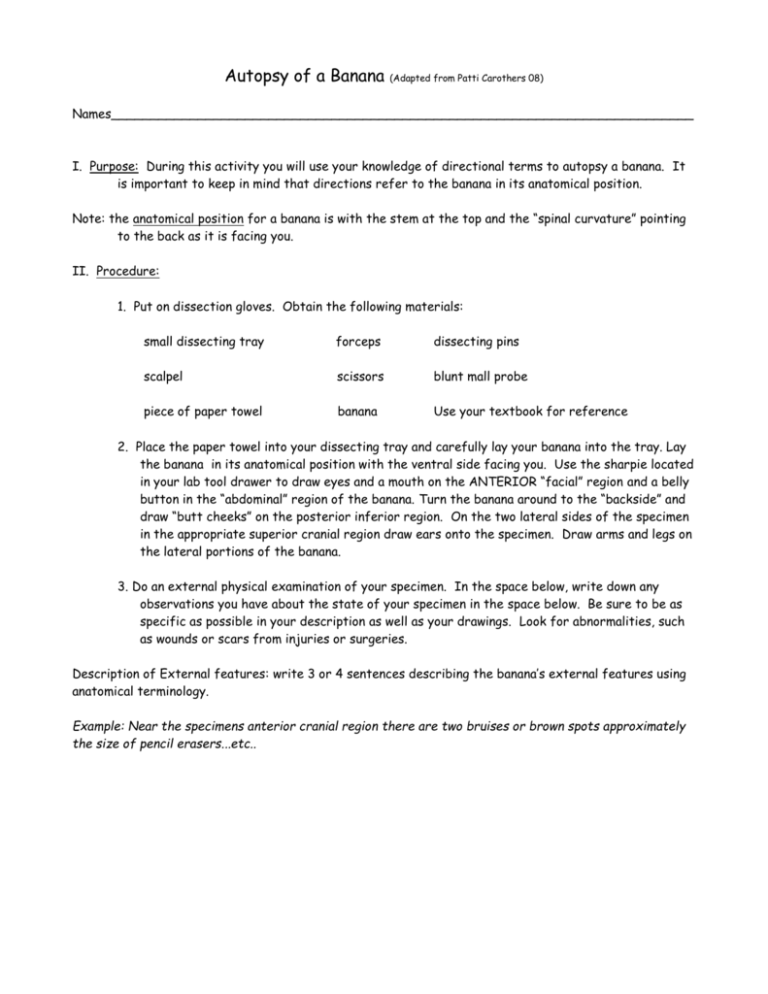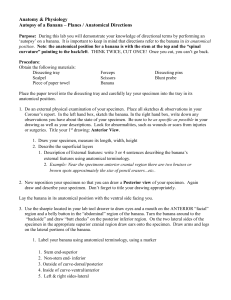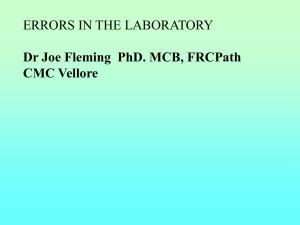Autopsy of a Banana (Adapted from Patti Carothers 08
advertisement

Autopsy of a Banana (Adapted from Patti Carothers 08) Names__________________________________________________________________________ I. Purpose: During this activity you will use your knowledge of directional terms to autopsy a banana. It is important to keep in mind that directions refer to the banana in its anatomical position. Note: the anatomical position for a banana is with the stem at the top and the “spinal curvature” pointing to the back as it is facing you. II. Procedure: 1. Put on dissection gloves. Obtain the following materials: small dissecting tray forceps dissecting pins scalpel scissors blunt mall probe piece of paper towel banana Use your textbook for reference 2. Place the paper towel into your dissecting tray and carefully lay your banana into the tray. Lay the banana in its anatomical position with the ventral side facing you. Use the sharpie located in your lab tool drawer to draw eyes and a mouth on the ANTERIOR “facial” region and a belly button in the “abdominal” region of the banana. Turn the banana around to the “backside” and draw “butt cheeks” on the posterior inferior region. On the two lateral sides of the specimen in the appropriate superior cranial region draw ears onto the specimen. Draw arms and legs on the lateral portions of the banana. 3. Do an external physical examination of your specimen. In the space below, write down any observations you have about the state of your specimen in the space below. Be sure to be as specific as possible in your description as well as your drawings. Look for abnormalities, such as wounds or scars from injuries or surgeries. Description of External features: write 3 or 4 sentences describing the banana’s external features using anatomical terminology. Example: Near the specimens anterior cranial region there are two bruises or brown spots approximately the size of pencil erasers...etc.. 4. Return your specimen to its anatomical position. Now carefully make a transverse cut about 2 inches inferior to the top of the "head" at the CERVICAL region of your specimen. Essentially you are decapitating the specimen. Make another transverse cut at the umbilical region. Your specimen is now in ____________ pieces. **Note: All drawings will show the INSIDE of your banana. 5. Draw the results of the transverse cut SURFACE made. The surfaces are now referred to as crosssection view. a. transverse cervical cut cross sectional view: b. transverse umbilical cut cross sectional view of inferior most portion of trunk section: 6. Using the Cranial region (the head) created in step 4, carefully make a Frontal/coronal incision (cut). Draw the anterior and posterior views resulting from this frontal incision below. The result of this cut is now referred to a longitudinal view. a. anterior longitudinal view: b. posterior longitudinal view: 7. Using the trunk section from step #4, make a midsagittal incision. Draw the left and right views of this midsagittal incision below. This also creates a longitudinal view. a. Right sagittal longitudinal view: b. Left sagittal longitudinal view: 8. Using the left sagittal section of the abdominal-pelvic region created from #7, make a parasagittal incision. Draw the left and right views of this parasagittal incision below. a. Right parasagittal longitudinal view: b. Left parasagittal longitudinal view: 9. Make an Oblique section through the section containing the legs . Draw the result of the cut below. a. cut surface of oblique section: 10. Now that you have thoroughly examined your specimen from all angles, thoroughly clean your lab area. All specimen and paper pieces need to be thrown away into lab waste. All equipment needs to be rinsed clean, dried and returned to its appropriate storage. Answer the post lab questions: a) How do a frontal and midsagittal section (cut) differ? b) When would an oblique section (cut) be most appropriate? c) How do a midsagittal and parasagittal section (cut) differ? d) In your own words, define the following words: a. section b. anterior/ventral c. dorsal/posterior d. midsagittal e. oblique f. parasagittal





